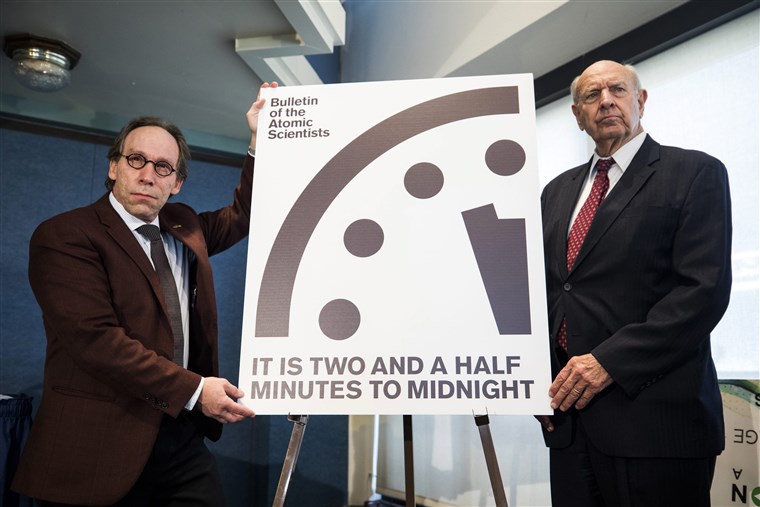2 Minutes to Midnight
July 14, 2018 | Expert Insights
Background:
The Doomsday Clock was created by the board of the Bulletin of the Atomic Scientists in 1947 as a response to nuclear threats. The concept is simple – the closer the minute hand is to midnight, the closer the board believes the world is to disaster. The nineteen members of the Bulletin’s Science and Security Board include national security experts, physicists, climate scientists, a public health expert and a cyber-security expert. The Board of Sponsors includes 15 Nobel laureates.
The clock was originally conceived by a group of atomic scientists who had been involved with the Manhattan Project, the scheme responsible for the first nuclear weapons. The Bulletin takes several factors into consideration when calculating the time on the clock: Nuclear threats, Climate change, Biosecurity, Bioterrorism and Miscellaneous threats including cyber warfare and AI
In 1947, the clock's hand sat at seven minutes to midnight to highlight the "urgency of nuclear dangers"
1949 - 3 minutes to midnight: The clock moved ever closer to midnight as the Soviet Union tested its first nuclear device
1953 - 2 minutes to midnight: The US created the hydrogen bomb
1963 - 12 minutes to midnight: Atmospheric nuclear testing ended
1984 - 3 minutes to midnight US-Soviet relations reached their frostiest level in years
1991 - 17 minutes to midnight: The Cold War ended and the clock jumped back
2015 - 3 minutes to midnight: 2015's Doomsday Clock was stuck at three minutes to midnight due to "unchecked climate change, global nuclear weapons modernisations and outsized nuclear weapons arsenals", all of which posed "an extraordinary and undeniable threat to the continued existence of humanity".
Analysis:
In 2017, world leaders failed to respond effectively to the looming threats of nuclear war and climate change, making the world security situation more dangerous than it was a year ago—and as dangerous as it has been since World War II.
Across the globe, nuclear weapons are poised to become more rather than less usable because of nations’ investments in their nuclear arsenals. US-Russia relations that now feature more conflict than cooperation have compounded nuclear risks. Coordination on nuclear risk reduction is all but dead, and no solution to disputes over the INF Treaty—a landmark agreement to rid Europe
of medium-range nuclear missiles—is readily apparent. Both sides allege violations, but Russia’s deployment of a new ground-launched cruise missile, if not addressed, could trigger a collapse of the treaty.
The world has seen the threat posed by the misuse of information technology and witnessed the vulnerability of democracies to disinformation. Last year, the US government pursued unwise and ineffectual policies on climate change, following through on a promise to derail past US climate policies. The Trump administration, which includes avowed climate denialists in top positions at the Environmental Protection Agency, the Interior Department, and other key agencies, has announced its plan to withdraw from the Paris Agreement.
The failure of world leaders to address the largest threats to humanity’s future is lamentable—but that failure can be reversed. It is two minutes to midnight, but the Doomsday Clock has ticked away from midnight in the past, and during the next year, the world can again move it further from apocalypse.
Assessment:
Our Assessment is that Leaders react when citizens insist they do so, and citizens around the world can use the power of the internet to improve the long-term prospects of their children and grandchildren. They can insist on facts, and discount nonsense. They can demand action to reduce the existential threat of nuclear war and unchecked climate change. They can seize the opportunity to make a safer and saner world.


